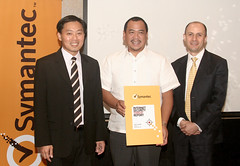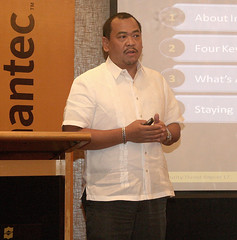Symantec Corporation
recently announced its findings on Internet Security Threat Report, (ISTR)
Volume 17, where our country, the Philippines ranked on the 39th
place among the countries that are on Internet threat activities, and just like last year, United
States of America still remains on the top of the list. For this reason,
Symantec Corporation is urging everyone, not just the government sector, but also the private
sector as well to aggressively secure their important files, data or whatever important
application and devices they may have from the constant threat such as: virus, mobile
threats, malware attacks and others brought by hackers that are spreading like
a wildfire on the internet. Aside from
that, Symantec’s Internet Security Threat Report (ISTR) also shows that while
the number of vulnerabilities decreased by 20 percent, the number of malicious
attacks continued to increase heavily by 81percent on a global basis.
SYMANTEC OFFICERS. In photo: (l-r) Mr. Ronnie Ng;
Senior Manager of Symantec Corp., Mr. Luichi Robles; Senior Country Manager of
Symantec Philippines and Mr. Kenedi Celik; Director of Strategic Sales, Asia
Pacific and Japan Symantec Corp.
Of all the the statistics that Symantec Corp. has released, what strucked me the most, is its findings with regards to the Most Harmful Websites by categories, and it turned out to be “Religion”. It is used to be pornography sites, but now it goes down to the 3rd spot and religion took the number one slot. This is something that is really thought-provoking, religion…..that is suppose to be the source of inspiration, godly messages and other faith-building articles, will suddenly turn out to be a tool for the very opposite of what it is suppose to be.
Symantec has made a lot of significant achievements
in the past, and just recently, it was able to blocked more than 5.5 billion
attacks, that if it were not blocked, the consequences of these attacks are
going to be catastrophic in the internet world.
For more information about Symantec, you may visit www.symantec.com
Annual Symantec Internet Security Threat
Report Reveals
81 Percent Increase in Malicious Attacks
(PRESS RELEASE)
Philippines ranked 39th among
countries globally on Internet Threat Activities
Symantec Corp. (Nasdaq: SYMC) today announced the findings of
its Internet Security Threat Report, Volume 17,
which shows that while the number of vulnerabilities decreased by 20 percent,
the number of malicious attacks continued to skyrocket by 81 percent globally. In addition, the report highlights that advanced
targeted attacks are spreading to organizations of all sizes and variety of
personnel, data breaches are increasing, and that attackers are focusing on mobile
threats.
Mr. Kenedi Celik, Symantec’s Director of Strategic Sales,
Asia Pacific and Japan as he discusses the Global Country Ranking for Malicious
Activity among 251 countries where our country the Philippines ranked on the 39th
place.
Mr. Luichi Robles, Symantec Philippines’ Senior
Country Manager as he discusses to the media the four key trends in Internet
threat report which are Malware Attacks, Targeted Attacks, Mobile Threats and
Data Breaches.
Mr. Ronnie Ng, Symantec’s Senior Manager for Systems
Engineering as he talks about the rise in number of Data Breaches Worldwide that are due to theft or loss, hacking and by making it on public accidentally.
Malicious Attacks Continue
to Grow Rapidly
Symantec blocked more than 5.5 billion malicious attacks in
2011, an increase of 81 percent over the previous year. In addition, the number of unique malware
variants increased to 403 million and the number of Web attacks blocked per day
increased by 36 percent.
At the same time, spam levels
fell considerably and new vulnerabilities discovered decreased by 20
percent. These statistics, compared to
the continued growth in malware, paint an interesting picture. Attackers have embraced easy to use attack toolkits
to efficiently leverage existing vulnerabilities. Moving beyond spam, cyber criminals are then
turning to social networks to launch their attacks. The very nature of these networks makes users
incorrectly assume they are not at risk and attackers are using these sites to
target new victims. Due to social
engineering techniques and the viral nature of social networks, it’s much easier
for threats to spread from one person to the next.
Advanced Targeted
Attacks Spread to Organizations of All Sizes
Targeted attacks are growing, with the number of daily
targeted attacks increasing from 77 per day to 82 per day by the end of
2011. Targeted attacks use social
engineering and customized malware to gain unauthorized access to sensitive
information. These advanced attacks have
traditionally focused on public sector and government; however, in 2011,
targeted attacks diversified.
Targeted attacks are no longer limited to large organizations. More than 50 percent of such attacks target organizations
with fewer than 2,500 employees, and almost 18 percent target companies with
fewer than 250 employees. These organizations may be targeted because they are
in the supply chain or partner ecosystem of a larger company and because they
are less well-defended. Furthermore, 58 percent of attacks target non-execs, employees
in roles such as human resources, public relations, and sales. Individuals in these jobs may not have direct
access to information, but they can serve as a direct link into the company. They are also easy for attackers to identify
online and are used to getting proactive inquiries and attachments from unknown
sources.
Rise of Data Breaches, Lost
Devices Concern for the Future
Approximately 1.1 million identities were stolen per data
breach on average in 2011, a dramatic increase over the amount seen in any
other year. Hacking incidents posed the
greatest threat, exposing 187 million identities in 2011—the greatest number for
any type of breach last year. However, the
most frequent cause of data breaches that could facilitate identity theft was
theft or loss of a computer or other medium on which data is stored or
transmitted, such as a smartphone, USB key or a backup device. These theft-or loss-related
breaches exposed 18.5 million identities.
As tablets and smartphones continue to outsell PCs, more
sensitive information will be available on mobile devices. Workers are bringing their smartphones and
tablets into the corporate environment faster than many organizations are able
to secure and manage them. This may lead
to an increase in data breaches as lost mobile devices present risks to
information if not properly protected. Recent research
by Symantec shows that 50 percent of lost phones will not be returned and 96
percent (including those returned) will experience a data breach.
Mobile Threats Expose
Businesses and Consumers
Mobile vulnerabilities increased by 93 percent in 2011. At
the same time, there was a rise in threats targeting the Android operating
system. With the number of
vulnerabilities in the mobile space rising and malware authors not only
reinventing existing malware for mobile devices, but creating mobile-specific
malware geared to the unique mobile opportunities, 2011 was the first year that
mobile malware presented a tangible threat to businesses and consumers. These
threats are designed for activities including data collection, the sending of
content, and user tracking.





No comments:
Post a Comment